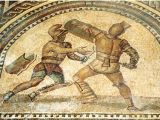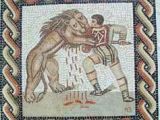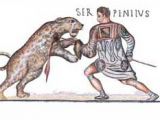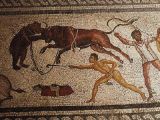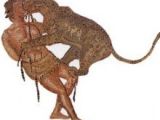It all started in 264 BC at the obsequies of Junius Brutus when, in the honor of his memory, three pairs of gladiators fought. Just three! 50 years later, Aemilius Lepidus threw in the arena 22 pairs of gladiators.
In 106 AD, celebrating his victory over the Dacians in an atmosphere of total lush, emperor Trajan offered 123 days of games in which 10,000 gladiators participated and 11,000 beasts were killed.
Many consider these games as an archaic reminiscence of Italic religious rites, of the human sacrifices once asked by the Saturn and other gods.
The animal sacrifices could have rooted in the symbols of the Rome founding: the she-wolf and the eagle.
During the lupercalia festivity, on the 15th of February, in the face of the Lupercal cavern where the legend said the she-wolf suckled Romulus and Remus, Romans sacrificed animals. In Latin, "munus" meant "obsequies" and "gladiator games", and "munere fungi" "to offer games", meaning "feast of death" for those hecatombs.
The repeated presence of the bull in the arena made many people associate these games with their meaning in the religion of Egypt, Middle East and Minoan (Crete, Atlantis) civilization. Could the Spanish bull-fights be a continuation of the Atlantis bull sacrifice?
Initially, the games were organized at the base of a hill, with a basic easy-to-dismantle furniture at the end of the show, later on the forum, the amplitude of the later games led to the building of an special edifice, amphitheatre, during the time of Augustus.
This was a massive building, of stone and marble and ellipsoidal shape, with two to four levels, having in the middle an arena surrounded by many rows of benches and harboring in its entrails a complicated labyrinth of passageways and "carceres" for gladiators and beasts, a "spoliarum", the place were the corpses were stored, complicated mechanisms of lifting the show materials or pipes to flood the arena in case of "naumahiae", simulated naval fights.
Over 200 amphitheatres were identified in the Roman world, the oldest at Pompeii, dated 70-65 BC.
Even in remote provinces, amphitheatres were built: in Dacia three such "buildings" were found (at Sarmisegetusa Ulpia Traiana, Porollisum now Moigrad-Salaj, and Apullum now Alba Iulia). These were "amphiteatrum castrense", reserved for the entertainment of the Roman army.
The largest and most known amphitheatre is Colosseum, built by Flavius Vespasian and inaugurated by Titus in 80 AD. Its proportions are indeed colossal, but its name comes from colossal statue of Nero placed on its front (but the statue did not resist time). The Colosseum had 80 entrances, of which three were reserved for the emperor and officials, and a capacity of about 80,000 seats.
A slattern pomp seems to have accompanied some games. Pliny the Elder said in his "Natural History" that the furniture was covered by gold, silver and amber.
The seats had soft pillows, and everywhere were wells bringing cold water while the air was refreshed by pulverizing water with saffron and perfumes wasted with ostentation, to show the generosity of the emperor.
After ending the Dacian wars, Trajan brought to Rome 165,500 kg of gold and 331,000 kg of silver: the victory was feasted for three years.
In Rome, the shows started at sunrise and continued all day, sometimes till late in the night. During the dawns, an execution took place: the throw to the beasts "ad bestias".
The start was given by Augustus, when revolted by the crimes committed by Seluros the bandit, he condemned him to be bound to a pile in the forum, and thrown to the hungry leopards. (does this remind you of the throwing to the lions of the prophet Daniel? Only he got out alive...)
Many wretches, men and women, guilty or supposedly guilty, were dragged during the dawns ad bestias.
This type of execution was "reserved" for slaves or free people who were not Roman citizens, but during the Christian persecutions, many of them experienced this rack.
Tacitus describes their massacring during Nero: "Their death was accompanied by mockery: they were covered in animal skins to be torn, hanged on crosses, or greased with inflammable stuffs to be used as torches during the night. Nero offered his gardens for these shows".
The Vatican is built over Nero's gardens ?
At midday, the blood of other victims reddened the arena's sand: that of "gladiatorii meridiani", selected exclusively from amongst assassins, thieves and rebels, condemned to die of sword "noxii ad gladium ludi damnati".
The first pair was pushed in the arena, just one of them being armed. Usually, the armed one defeated its adversary and he, too, was disarmed and forced to fight with another armed fighter and this continued till the last one.
These two fight types were scheduled for incommode hours: in the morning the amphitheatre just started to fill and at midday when it was getting empty for lunch.
The proper gladiator fights, "hoplomachiae" offered, even if minimal, a chance. In its clemency moments, the public spared the life of a defeated that had delighted them with his art, and the winners that managed to resist for three years, received "rudis", the wooden sword, the sign of liberation. A favorite confrontation was between one thaex (sworded gladiator wearing iron helmet and armor) and a retiarius fighting with a weighed net (rete), a trident and a dagger.
Organized at the top afternoon hours, besides gladiator fights were organized "venetiones", the hunts, which met the suffrages of the public.
The Venationes were of many types: parades aimed to amaze, exhibitions similar to circus acts, aiming to amuse, and the proper hunts that were as full of horrors as the interposing massacres. The start was given in 275 BC, with the parade of four elephants captured by the Romans during the war against Pyrrhus of Epirus.
In 251 BC, the parade of 100 elephants captured at Palermo, in the second Punic war, make disappear the fright provoked by the appearance during the full fight of the giant beasts.
Exotic curiosities were exposed to public, like crocodiles from Egypt, pythons or peacocks brought from India. But well kept Roman mosaics describe the cruel hecatombs.
Beats were forced to exterminate one to another, like pairs bear-bull, rhinoceros-bull or others. Sometimes, a bestiarius, gladiator specialized in animal fights, provoked restlessly the beasts.
Sometimes the public (and even officials from the imperial lodge, like in the case of Commodus, the emperor from the movie "Gladiator") threw spears and arrows at the beasts.
In other occasions, the fight was between a bestiarius and a beast.
The gladiator tried to achieve public's ovations by killing the bear with punches, increasing the peril of fighting angry bulls with spectacular jumps (like those made today by bull-fighters), choking the lion in the folds of his mantle, executing extraordinary pole vault to avoid beasts' blows or provoking them till paroxysm while the beats were still in the cages.
The gladiator-beast fights were extremely appreciated and usually ended a munera day.
To confer more greatness to the confrontation with the beasts, it was often displayed in a d?cor of trees, rocks, and caverns. "By the request of Probus, a great number of mighty trees, pulled out with roots, were planted in the middle of the arena. The vast and shady forest was filled with 1,000 ostriches, 1,000 red deer, 1,000 roe deer, and 1,000 wild boars and all this variety of game was let prey to the onrush of the unleashed mob. The massacre of the next day consisted of 200 lions and lionesses, 200 leopards and 300 bears".
These numbers are a little exaggerated, but at the inaugural munera of the Colosseum, Titus sacrificed 5,000 beasts, while in two munera, Trajan sacrificed 2,246 respectively 2,243 animals.
Accompanied by dog packs, armed with spears and spikes, fired smuts, bows and daggers, the gladiators reproduced a real hunt. This type of confrontation was more sportive, as it exposed animals and men to similar danger levels.
Sometimes, mythological or epic stories were transposed into the arena.
Gradually, the games lost intensity, and the number of sacrificed animals decreased, too.
In 248 AD, at the celebration of the Rome's secular games, just 32 elephants, 10 tigers, 60 lions, 30 leopards, 10 hyenas, 6 hippopotamus, 10 zebras, 1 rhinoceros, 10 giraffes, 50 wild donkeys, and 1,000 pairs of gladiators passed through the Colosseum. This is little compared to Trajan's 11,000 beasts and 10,000 gladiators.
Most of the beast came from the north African Roman provinces, but after repeated massacres and hunts, they disappeared from the region.
A tragic reality: this is the time when the African elephant disappeared from North Africa, and the Asian elephant and Indian rhinoceros disappeared from the Middle East.
In a munera from 404 AD the mob tore apart the monk who dared, by descending into the arena, to protest against the gladiator fights but in the same year, the emperor Honorius abolished these cruel games.
The moral hint of the gesture had been achieved. One century later, in 523 AD, animal fights, too, were prohibited. The mosaics and the sad ruins of the amphitheatres are today the only witnesses of the arena hells.
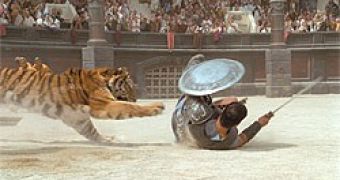
 14 DAY TRIAL //
14 DAY TRIAL // 
